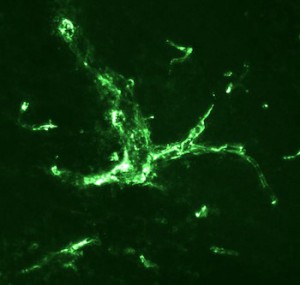*Quantitation of cerebral capillary immunofluorescence images
Research team: Dr. Matt Albrecht, Mr. Corey Giles, Prof. John Mamo, Dr. Ryu Takechi, Dr. Virgine Lam. CIC specialist: Dr. Kevin Chai
Working over at the Curtin Health Innovation Research Institute (CHIRI), our group has a specialised interest in exploring the relationship between blood brain barrier (BBB) leakage and cognitive decline. To do this, we collect images in mouse models using interventions that impair, restore, and/or maintain BBB function. The images are generated by fluorescence staining of brain slices for the protein immunoglobulin G (IgG). This enables visualization of brain capillary structures and leakage of IgG out of the capillary under a microscope. In our images, capillaries present as distinct branch like structures with a relatively well defined trajectory, while BBB-leakage presents as diffuse fluorescence with little definable form (see figure below). Human derived quantitation of these images for BBB-leakage is time consuming, taking weeks for a researcher to classify the data obtained within a single study. Moreover, while consistency in classification amongst multiple people is relatively high, differences between raters and images is an unavoidable occurrence due to natural human fluctuations in attention and strategy. Our intention was therefore to collaborate with the CIC specialists to explore and ultimately implement a machine learning (deep learning) model for automated image processing and quantitation of BBB leakage in our immunofluorescent data. So far, we have a highly promising model that can classify 1,000s of images in seconds and the quantitations correlate strongly with human aided quantitation. This speed can be compared to the human time to complete this task of weeks to months. Our next steps are to stress test the model with further validation on different experiments to hopefully improve the quantitation ability of the model.
Figure: Immunofluorescence image of a brain capillary showing some leakage across the blood brain barrier.
Please contact the research team or CIC for more information.
* source: CIC Quarterly Newsletter.
